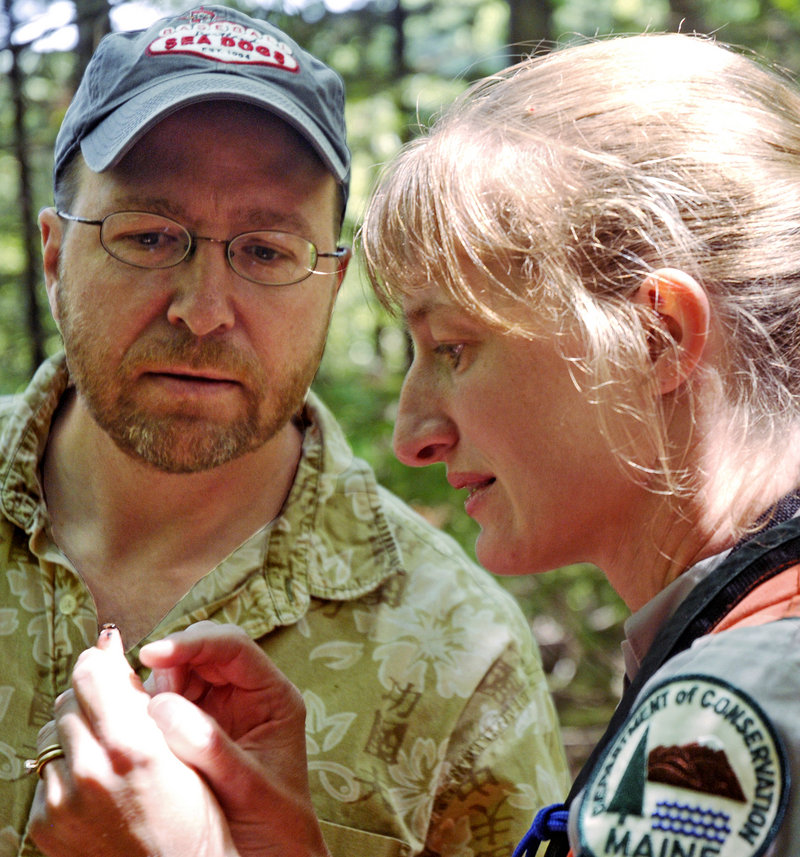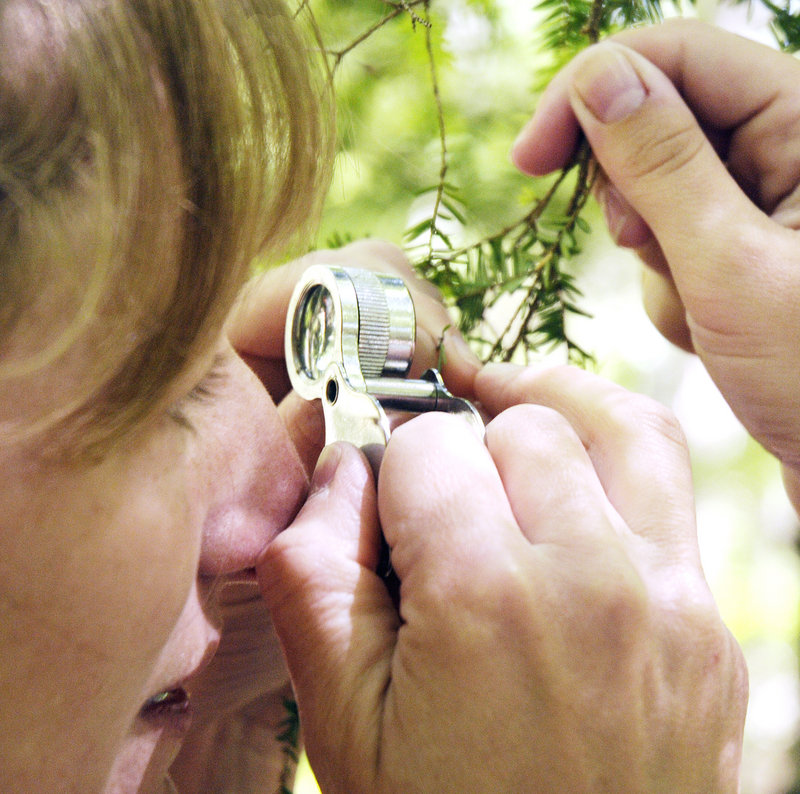HARPSWELL – Soon after I began looking for the hemlock woolly adelgid — a tiny forest pest about the size of a very small poppy seed — I realized it was looking like the proverbial needle in a haystack.
On steroids.
That’s because to find the hemlock woolly adelgid, I was searching in the 93-acre Long Reach Preserve, with hundreds of trees in sight at any given moment.
The first thing I had to learn was how to spot a hemlock, by its flat needles and somewhat droopy branches. Then I had to search for this speck of a pest one branch at a time. And then, if I saw something that looked even remotely like the hemlock woolly adelgid, I had to use a magnifying glass to survey the branch right down to its teeny, tiny needles.
“We could be out here for a couple of hours and find nothing,” said Allison Kanoti, a forest entomologist with the Maine Forest Service, based in Augusta. “It can get pretty repetitious. We check as many branches as we can, and sometimes we just start thinking we’re seeing them when we’re not.”
Keeping that in mind, I was excited but cautious when I finally found a tiny white blob on the underside of a hemlock branch.
It was definitely white, so I took out the hand-held magnifying lens that Kanoti had given me and took a second look. Not really woolly or cottony, as Kanoti had told me the adelgid would be. But it was the first white speck I had found after an hour in the woods, so I called Kanoti over.
“That’s a spittlebug. See that frothy mass around it? That’s how you can tell,” she told me.
So I made a mental note: not frothy, woolly. What I wanted to find was something white and woolly.
About 30 minutes later, Kanoti and Amanda Sawyer, a Forest Service intern from Gorham, did find a single hemlock woolly adelgid. They put a pink ribbon on the tree to mark the area — the Forest Service uses pink because it’s easy to see and not a lot of other folks use it.
Kanoti, who travels the state looking for forest pests that can cause damage and upset the ecosystem, had come to Long Reach Preserve on a sort of hunch. The hemlock woolly adelgid is a pest on the upswing this year, largely because of a weirdly mild winter. That allowed many more of them to survive.
A large infestation was detected in May near Cundy’s Harbor, on the eastern side of Harpswell. Kanoti and others felt that the bugs could have been carried, by wind maybe, along water sources to areas nearby. So they called people in the area, looking for large stands of hemlock, near streams or other water sources.
And that’s how they came to Long Reach Preserve. And Kanoti was right.
So why, exactly, were we searching for tiny bugs branch by branch in a forest full of branches and tiny bugs?
Because the hemlock woolly adelgid kills hemlock trees, and hemlock trees are an important part of the ecosystem in Maine, Kanoti told me. They provide shelter, shade and food for a variety of plants and animals.
Entomologists are trained to study insects. As a forest entomologist, Kanoti looks for pests that can destroy trees and then works on quarantining areas — basically regulating and managing the movement of trees or wood in and out of that area.
The hope is that quarantining an area will stop the spread of the pest. So it’s important to know where they are, and that was the point of the work the day I followed Kanoti.
More than half of her job is done indoors. That’s where she calls landowners, town officials and others, looking for potentially infested areas or areas where an infestation is likely to reach.
She also spends time talking to landowners and others about pests, how to spot them and how to manage them, and teaches workshops on pests.
While she likes being out in the field, it does have its perils. We got eaten alive by mosquitoes on the day I was out with her, and we got a little lost driving around on Harpswell’s peninsulas and hiking through the woods.
Also, trying to check a lot of branches meant scanning branches both high and low. So I was craning my neck a lot and pulling many branches lower to the ground. And I’m sure I was duplicating my efforts, by checking the same branches twice.
I could hardly tell a spruce from a hemlock, never mind one hemlock branch from another.
I didn’t find any hemlock woolly adelgids myself, but I did find several spittlebugs, and mealybugs, and some moth larvae.
“It’s a relief to find (hemlock woolly adelgids), even though you don’t really want to find them,” said Kanoti. “It’s just a relief to know you didn’t miss them.”
Staff Writer Ray Routhier can be contacted at 791-6454 or at:
rrouthier@pressherald.com
Send questions/comments to the editors.




